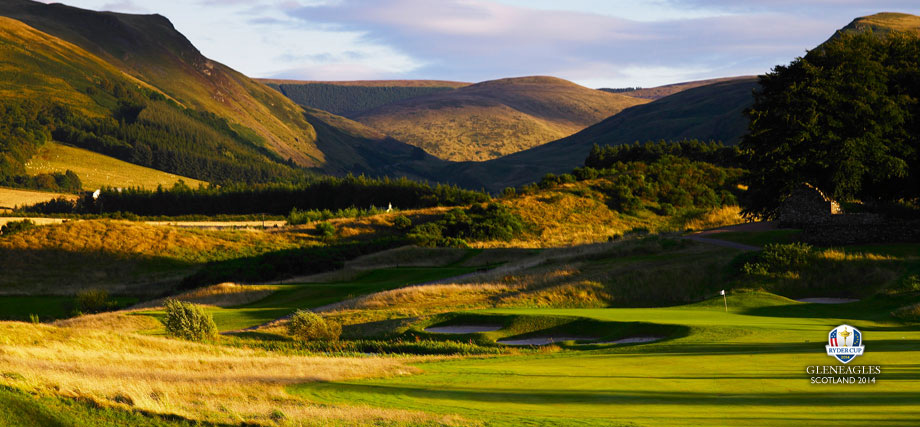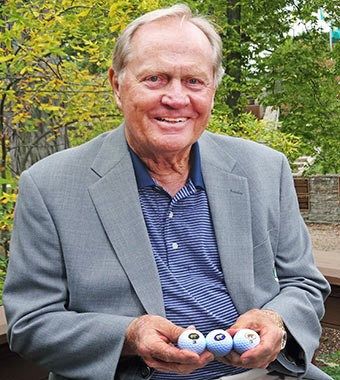Lost in the excitement leading up to Friday’s start to the 2014 Ryder Cup was the controversy surrounding the opening of the now PGA Centenary Course at Gleneagles.
Designed by the legendary Jack Nicklaus, the Monarch’s course as it was then known, was the first golf course in Scotland to boast motorised cart paths.
However the initial cries of ‘sacrilegious’ soon gave way to acclaim when the course was open to the public on May 15th, 1993.
In meeting with then Managing Director Peter Lederer and Golf Courses and Estate Director Jimmy Kidd, Nicklaus described the land on which he would go to work in Scotland as “the finest in the world I have ever been given to work with. Great terrain; nice rolling turf; a lot of terrific places; beautiful views—when you see the views.”

The PGA Centenary Course, or the Monarchs Course as it was christened, caused controversy when opened – the first golf course in Scotland to have motorised cart paths.
That’s so true with the commencement of the course playing southeast towards the glen, sweeping views up to the Ochil Hills to the summit of the pass below Ben Shee which joins it to Glendevon.
As you move westwards around the course, the rugged Grampians come into view on the right, then the distantly purple ahead, Ben Vorlich and the mountains above the Trossachs.
It had been Donald Matheson, General Manager of the Caledonian Railway Company, in 1910 who was on holiday in Strathearn when he proposed the idea of building a ‘Grand Hotel’ and three golf courses.
Plans were submitted in 1912 with work commencing in 1913 but the outbreak of World War 1 saw work until May 1st, 1919 when the James Braid designed King’s Course was officially opened, then followed by the Queen’s Course that was initially nine holes.
The stunning Gleneagles Hotel, with its own railway station less than a mile away, finally opened on 7th June, 1924 and described as ‘A Riviera In the Highlands’ and ‘the eighth wonder of the world’.
In appointing Braid, Matheson also knew the quality of the courses would provide the opportunity for professional competition, which started with a tangible link to The Ryder Cup when an historic, first-ever “International Challenge Match” was played on The King’s Course between British and American professionals on June 6, 1921, as a prelude to the Glasgow Herald 1,000 Guineas tournament.
Nevertheless, while the match and the tournament won the plaudits of the players and the spectators, the Americans were not entirely impressed by their accommodation, since construction had only just re-started on the hotel. They were compelled to fetch and carry their own water to the five waterless railway carriages in which they were housed in a siding at the station near Auchtermuchty in Fife.

Jack Nicklaus designed the PGA Centenary Course but would he know that it was the first golf course in the Home of Golf to have motorised cart paths.
Nicklaus first visited Gleneagles in 1966 for a famous “Big Three” match with Arnold Palmer and Gary Player on The King’s Course.
However Ian Marchbank, the Gleneagles head professional from 1962 to 1992, admits to in 1971 “trying very hard to promote Gleneagles as a potential venue” despite being aware at the time that the next edition would be taking place at Muirfield.
In March, 1988 Nicklaus signed a contract with Gleneagles to build his first course in Scotland with the aim being to create a 21st century challenge that would complement the existing King’s and Queen’s courses.
The new course would be built on a site occupied at that time by the courses named Glendevon, opened in 1980, and Prince’s, which began life as the Wee Course in 1928 and was extended to 18 holes in 1974.
On January 1st, 2001 the Monarch Course was named The PGA Centenary Course to commemorate the PGA’s Centenary Year.
Three years ago, Nicklaus was invited to ‘modernise and re-invigorate’ the Centenary Course ahead of the Gleneagles hosting the Ryder Cup.
Nicklaus explained: “When we built the course it was a pretty challenging layout. With the equipment and the golf ball—in 1993 we were still using wound balls—and everything going much farther, it needed alterations. So we set out to make it more relevant in today’s game, from some the bunkering to the strategy.”
Over 50,000 tonnes of earth were moved over a six month alteration period in the winter of 2011-12 to 12 holes, and with 30,000 square meters of new turf laid, and 1,000 tonnes of new sand for bunkering. Improvements were made to the drainage in all the bunkers, using a ‘Better Billy Bunker Method’ developed at Augusta National
The most significant changes being made to the 18th holes, and with current Head Professional, Andrew Jowlett remarking: “It would be fair to say the previous 18th had a terrible atmosphere and didn’t give the course the finish it deserved.
“You’ve now got a full stadium hole where the crowd can line it from basically tee up to and around the green.
“There will be a phenomenal atmosphere if any of the matches come down to this last hole as it is a great example of a risk and reward par five.
“Hopefully, the Europeans will not need to play the 18th but if the final putt to win the Ryder Cup comes down to the final green on the Sunday then what a theatre the 18th green will provide.”
So from the shock of seeing ‘American-like’ cart paths, the sporting world will look on in awe of the Nicklaus designed PGA Centenary Course that proudly showcase the best Americans against the best of Europe.



